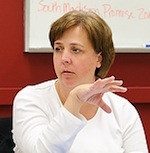Journalism students learn ethics through online case study
You’re a college student working for a news service, and your editor asks you to check out a breaking-news situation.
You head to the scene, where you learn a teen singing sensation, Caitlyn Isaac, may have overdosed at her hotel following a concert.
What do you do? Who do you interview? And when do you know you’ve got a story ready to go?

Culver
Students in the School of Journalism and Mass Communication‘s J202: Mass Media Practices course at the University of Wisconsin–Madison found themselves in this hypothetical reporter’s shoes, working through a series of ethical questions involved in the newsgathering situation by way of an online case-study module.
The situational case study, presented in a “choose your own adventure” style format, is an example of how faculty and teaching staff across the UW campus are using technology to enhance students’ learning experiences.
“We know how to teach them to write a lead [to a news story], but it’s hard to approximate getting them to think on their feet and evaluate sources of information,” says Michael Mirer, the lead teaching assistant for J202 this spring, who used the case-study scenario in class last semester.
A campuswide effort called Educational Innovation is prompting the development of new and different ways of teaching. While some of that involves top-to-bottom changes to programs or classes, many faculty and teaching staff find smaller-scale exercises such as the journalism case study can be just as enriching.
The module was developed by Katy Culver, assistant professor of journalism and mass communication, with Mitchell Bard, the lead teaching assistant in the fall semester, and a team from the Division of Information Technology (DoIT), led by Ron Cramer, senior learning technology consultant within DoIT’s Academic Technology group.
Students used the journalism case-study module for the first time in the fall semester. In past semesters, they would have read about a real-life case study and discussed it in a lab for the course.
The situational case study, presented in a “choose your own adventure” style format, is an example of how faculty and teaching staff across the UW campus are using technology to enhance students’ learning experiences.
“There was nothing wrong with those discussions, but I don’t really know if they stuck, because the students hadn’t gone through the reasoning,” Culver says.
Throughout the reporting scenario, students meet different people to interview and make decisions about what path is most likely to produce a solid story. For example, talking to bartenders and hotel workers leads students down a dead end without reliable information, but conversations with the hotel manager and the police public relations officer put the reporter on the right path.
At the same time, the reporter’s editor is sending text messages that demand a story as soon as possible. Students learn not only about the deadline pressure of journalism, but also about the reporter’s responsibility to decide when there’s enough information to publish a credible story.
“I liked talking about it this way. ‘When do you go with it? When do you have enough? When are you confident you have the truth?’ Sometimes it’s OK not to report — sometimes you don’t have it,” Mirer says.
Culver has developed a range of blended learning activities for J202 to maximize students’ time in and out of class, and earlier this year she approached DoIT Academic Technology about developing a situated learning experience.
Cramer suggested using DoIT Academic Technology’s “Case Scenario/Critical Reader” tool.
“When I saw it for the first time in the summer, the example was for medical students — you’re a gynecology resident and the woman presents with this or that,” Bard says. “What could be more different than what we’re doing? But it was immediately obvious that this would work for us.”
The idea for the journalism case study, which takes about 15 minutes for students to complete, started on one sheet of paper with Culver and Bard’s initial ideas for what might work. The story expanded to bigger sheets of paper and an elaborate backstory the pair developed, even as they resisted the urge to broaden the exercise.
And to be compelling, the scenario also needed to follow a design framework developed by DoIT Academic Technology called “the seven Cs”: content, context, challenge, characters, choices, consequences and connections.
“The biggest challenge is getting all pieces into something that’s a cohesive narrative and meets the learning objective,” Cramer says.
People who are interested in developing a situational-case scenario can contact DoIT Academic Technology to learn more, Cramer says.




